Development of Integrated Crop Drought Index by Combining Rainfall, Land Surface Temperature, Evapotranspiration, Soil Moisture, and Vegetation Index for Agricultural Drought Monitoring
Abstract
1. Introduction
2. Materials
3. Methods
3.1. Integrated Crop Drought Index (ICDI)
3.2. Performance Evaluation
3.3. ICDI Classification
4. Results and Discussion
4.1. Characteristics of Drought by Period and County
4.2. Comparison with Other Drought Indices
4.3. Relationship between Drought Index and Crop Yield
5. Conclusions
Author Contributions
Funding
Data Availability Statement
Conflicts of Interest
Abbreviations
| AWC | Available water content |
| Corr. | Correlation coefficient |
| ECDF | Empirical cumulative distribution function |
| eEVI | EVI in ECDF percentile unit |
| eLST | LST in ECDF percentile unit |
| ePET | PET in ECDF percentile unit |
| eRain | Rain in ECDF percentile unit |
| eSM | SM in ECDF percentile unit |
| EVI | Enhanced Vegetation Index |
| FC | Field capacity |
| GLDAS | Global Land Data Assimilation System |
| ICDI | Integrated Crop Drought Index |
| LST | Land surface temperature |
| MODIS | Moderate Resolution Imaging Spectroradiometer |
| NASS | National Agricultural Statistics Service |
| NDVI | Normalized Difference Vegetation Index |
| NESDIS | NOAA National Environmental Satellite, Data, and Information Service |
| OPI | Optimal Productivity Index |
| PCI | Precipitation Condition Index |
| PDSI | Palmer Drought Severity Index |
| PET | Potential evapotranspiration |
| RMSE | Root Mean Square Error |
| SDCI | Scaled Drought Condition Index |
| SI | Severity index |
| SM | Soil moisture content |
| SPEI | Standardized Precipitation Evapotranspiration Index |
| SPI | Standardized Precipitation Index |
| SWDI | Soil Water Deficit Index |
| TCI | Temperature Condition Index |
| TRMM | Tropical Rainfall Measuring Mission |
| USDA | United States Department of Agriculture |
| USDM | United States Drought Monitor |
| USGS | United States Geological Survey |
| VCI | Vegetation Condition Index |
| VegDRI | Vegetation Drought Response Index |
| VHI | Vegetation Health Index |
Appendix A

References
- Allen, C.D.; Macalady, A.K.; Chenchouni, H.; Bachelet, D.; McDowell, N.; Vennetier, M.; Kitzberger, T.; Rigling, A.; Breshears, D.D.; Hogg, E.H.; et al. A global overview of drought and heat-induced tree mortality reveals emerging climate change risks for forests. For. Ecol. Manag. 2010, 259, 660–684. [Google Scholar] [CrossRef]
- Mora, C.; Spirandelli, D.; Franklin, E.C.; Lynham, J.; Kantar, M.B.; Miles, W.; Smith, C.Z.; Freel, K.; Moy, J.; Louis, L.V.; et al. Broad threat to humanity from cumulative climate hazards intensified by greenhouse gas emissions. Nat. Clim. Chang. 2018, 8, 1062–1071. [Google Scholar] [CrossRef]
- He, X.; Estes, L.; Konar, M.; Tian, D.; Anghileri, D.; Baylis, K.; Evans, T.; Sheffield, J. Integrated approaches to understanding and reducing drought impact on food security across scales. Curr. Opin. Environ. Sustain. 2019, 40, 43–54. [Google Scholar] [CrossRef]
- Javadinejad, S.; Dara, R.; Jafary, F. Analysis and prioritization the effective factors on increasing farmers resilience under climate change and drought. Agric. Res. 2020, 9, 1–17. [Google Scholar]
- Spinoni, J.; Barbosa, P.; De Jager, A.; McCormick, N.; Naumann, G.; Vogt, J.V.; Magni, D.; Masante, D.; Mazzeschi, M. A new global database of meteorological drought events from 1951 to 2016. J. Hydrol. Reg. Stud. 2019, 22, 100593. [Google Scholar] [CrossRef]
- Le Page, M.; Zribi, M. Analysis and predictability of drought in Northwest Africa using optical and microwave satellite remote sensing products. Sci. Rep. 2019, 9, 1466. [Google Scholar] [CrossRef]
- Cook, E.R.; Seager, R.; Cane, M.A.; Stahle, D.W. North American drought: Reconstructions, causes, and consequences. Earth Sci. Rev. 2007, 81, 93–134. [Google Scholar] [CrossRef]
- Alvala, R.; Cunha, A.P.; Brito, S.S.; Seluchi, M.E.; Marengo, J.A.; Moraes, O.L.; Carvalho, M.A. Drought monitoring in the Brazilian Semiarid region. An. Acad. Bras. Ciênc. 2019, 91, 1–15. [Google Scholar] [CrossRef] [PubMed]
- Wilhite, D.A. Chapter 1 Drought as a Natural Hazard: Concepts and Definitions. In Drought: A Global Assessment; Wilhite, D.A., Ed.; Routledge: London, UK, 2000; Volume 1, pp. 3–18. [Google Scholar]
- McKee, T.B.; Doesken, N.J.; Kleist, J. The relationship of drought frequency and duration to time scales. In Proceedings of the 8th Conference on Applied Climatology, Anaheim, CA, USA, 17–22 January 1993. [Google Scholar]
- Almedeij, J. Drought analysis for kuwait using standardized precipitation index. Sci. World J. 2014, 2014, 451841. [Google Scholar] [CrossRef] [PubMed]
- Wilhite, D.A.; Glantz, M.H. Understanding: The drought phenomenon: The role of definitions. Water Int. 1985, 10, 111–120. [Google Scholar] [CrossRef]
- Mishra, A.K.; Singh, V.P. A review of drought concepts. J. Hydrol. 2010, 391, 202–216. [Google Scholar] [CrossRef]
- Van Loon, A.F. Hydrological drought explained. WIREs Water 2015, 2, 359–392. [Google Scholar] [CrossRef]
- Wilhite, D.A.; Svoboda, M.D. Drought early warning systems in the context of drought preparedness and mitigation. In Proceedings of the An Expert Group Meeting on Early Warning Systems, Lisbon, Portugal, 5–7 September 2000. [Google Scholar]
- Zhao, M.; Huang, S.; Huang, Q.; Wang, H.; Leng, G.; Xie, Y. Assessing socio-economic drought evolution characteristics and their possible meteorological driving force. Geomat. Nat. Hazards Risk 2019, 10, 1084–1101. [Google Scholar] [CrossRef]
- Guo, Y.; Huang, S.; Huang, Q.; Wang, H.; Fang, W.; Yang, Y.; Wang, L. Assessing socioeconomic drought based on an improved Multivariate Standardized Reliability and Resilience Index. J. Hydrol. 2019, 568, 904–918. [Google Scholar] [CrossRef]
- Kogan, F.; Guo, W.; Yang, W. Drought and food security prediction from NOAA new generation of operational satellites. Geomat. Nat. Hazards Risk 2019, 10, 651–666. [Google Scholar] [CrossRef]
- Rippey, B.R. The US drought of 2012. Weather Clim. Extrem. 2015, 10, 57–64. [Google Scholar] [CrossRef]
- Goulden, M.L.; Bales, R.C. California forest die-off linked to multi-year deep soil drying in 2012–2015 drought. Nat. Geosci. 2019, 12, 632–637. [Google Scholar] [CrossRef]
- Dalezios, N.R.; Dunkel, Z.; Eslamian, S. Meteorological drought indices: Definitions. In Handbook of Drought and Water Scarcity, Principles of Drought and Water Scarcity; Eslamian, S., Eslamian, F., Eds.; CRC Press: New York, NY, USA, 2017; Volume 1, pp. 27–44. [Google Scholar]
- Homdee, T.; Pongput, K.; Kanae, S. A comparative performance analysis of three standardized climatic drought indices in the Chi River basin, Thailand. Agric. Nat. Resour. 2016, 50, 211–219. [Google Scholar] [CrossRef]
- Parsons, D.J.; Rey, D.; Tanguy, M.; Holman, I.P. Regional variations in the link between drought indices and reported agricultural impacts of drought. Agric. Syst. 2019, 173, 119–129. [Google Scholar] [CrossRef]
- Moorhead, J.E.; Gowda, P.H.; Singh, V.P.; Porter, D.O.; Marek, T.H.; Howell, T.A.; Stewart, B.A. Identifying and evaluating a suitable index for agricultural drought monitoring in the Texas high plains. J. Am. Water Resour. Assoc. 2015, 51, 807–820. [Google Scholar] [CrossRef]
- Gunda, T.; Hornberger, G.M.; Gilligan, J.M. Spatiotemporal patterns of agricultural drought in Sri Lanka: 1881–2010. Int. J. Climatol. 2016, 36, 563–575. [Google Scholar] [CrossRef]
- Martínez-Fernández, J.; González-Zamora, A.; Sánchez, N.; Gumuzzio, A. A soil water based index as a suitable agricultural drought indicator. J. Hydrol. 2015, 522, 265–273. [Google Scholar] [CrossRef]
- Martínez-Fernández, J.; González-Zamora, A.; Sánchez, N.; Gumuzzio, A.; Herrero-Jiménez, C.M. Satellite soil moisture for agricultural drought monitoring: Assessment of the SMOS derived Soil Water Deficit Index. Remote Sens. Environ. 2016, 177, 277–286. [Google Scholar] [CrossRef]
- Sruthi, S.; Aslam, M.M. Agricultural drought analysis using the NDVI and land surface temperature data; a case study of Raichur district. Aquat. Procedia 2015, 4, 1258–1264. [Google Scholar] [CrossRef]
- Dutta, D.; Kundu, A.; Patel, N.R. Predicting agricultural drought in eastern Rajasthan of India using NDVI and standardized precipitation index. Geocarto Int. 2013, 28, 192–209. [Google Scholar] [CrossRef]
- Sholihah, R.I.; Trisasongko, B.H.; Shiddiq, D.; La Ode, S.I.; Kusdaryanto, S.; Panuju, D.R. Identification of agricultural drought extent based on vegetation health indices of Landsat data: Case of Subang and Karawang, Indonesia. Procedia Environ. Sci. 2016, 33, 14–20. [Google Scholar] [CrossRef]
- Kogan, F.N. Operational space technology for global vegetation assessment. Bull. Am. Meteorol. Soc. 2001, 82, 1949–1964. [Google Scholar] [CrossRef]
- Brown, J.F.; Wardlow, B.D.; Tadesse, T.; Hayes, M.J.; Reed, B.C. The Vegetation Drought Response Index (VegDRI): A new integrated approach for monitoring drought stress in vegetation. GIsci. Remote Sens. 2008, 45, 16–46. [Google Scholar] [CrossRef]
- Brown, J.F. Drought Monitoring with VegDRI; United States Geological Survey: Reston, VA, USA, 2010.
- Rhee, J.; Im, J.; Carbone, G.J. Monitoring agricultural drought for arid and humid regions using multi-sensor remote sensing data. Remote Sens. Environ. 2010, 114, 2875–2887. [Google Scholar] [CrossRef]
- Svoboda, M.; Hayes, M.; Wood, D.A. Standardized Precipitation Index User Guide; World Meteorological Organization (WMO): Geneva, Switzerland, 2012; pp. 1–24. [Google Scholar]
- Hayes, M.J.; Svoboda, M.D.; Wiihite, D.A.; Vanyarkho, O.V. Monitoring the 1996 drought using the standardized precipitation index. Bull. Am. Meteorol. Soc. 1999, 80, 429–438. [Google Scholar] [CrossRef]
- Vicente-Serrano, S.M.; Beguería, S.; López-Moreno, J.I. A multiscalar drought index sensitive to global warming: The standardized precipitation evapotranspiration index. J. Clim. 2010, 23, 1696–1718. [Google Scholar] [CrossRef]
- Piedallu, C.; Gégout, J.C.; Perez, V.; Lebourgeois, F. Soil water balance performs better than climatic water variables in tree species distribution modelling. Glob. Ecol. Biogeogr. 2013, 22, 470–482. [Google Scholar] [CrossRef]
- Manning, C.; Widmann, M.; Bevacqua, E.; Van Loon, A.F.; Maraun, D.; Vrac, M. Soil moisture drought in Europe: A compound event of precipitation and potential evapotranspiration on multiple time scales. J. Hydrometeorol. 2018, 19, 1255–1271. [Google Scholar] [CrossRef]
- Szewczak, K.; Łoś, H.; Pudełko, R.; Doroszewski, A.; Gluba, Ł.; Łukowski, M.; Rafalska-Przysucha, A.; Słominski, J.; Usowicz, B. Agricultural Drought Monitoring by MODIS Potential Evapotranspiration Remote Sensing Data Application. Remote Sens. 2020, 12, 3411. [Google Scholar] [CrossRef]
- Pham, H.X.; Shamseldin, A.Y.; Melville, B.W. Assessment of climate change impact on water balance of forested and farmed catchments. J. Hydrol. Eng. 2015, 20, 04015009. [Google Scholar] [CrossRef]
- Cowley, G.S.; Niemann, J.D.; Green, T.R.; Seyfried, M.S.; Jones, A.S.; Grazaitis, P.J. Impacts of precipitation and potential evapotranspiration patterns on downscaling soil moisture in regions with large topographic relief. Water Resour. Res. 2017, 53, 1553–1574. [Google Scholar] [CrossRef]
- Lozano-Parra, J.; Schnabel, S.; Pulido, M.; Gómez-Gutiérrez, Á.; Lavado-Contador, F. Effects of soil moisture and vegetation cover on biomass growth in water-limited environments. Land Degrad. Dev. 2018, 29, 4405–4414. [Google Scholar] [CrossRef]
- Beguería, S.; Vicente-Serrano, S.M.; Reig, F.; Latorre, B. Standardized precipitation evapotranspiration index (SPEI) revisited: Parameter fitting, evapotranspiration models, tools, datasets and drought monitoring. Int. J. Climatol. 2014, 34, 3001–3023. [Google Scholar] [CrossRef]
- Tian, Y.; Xu, Y.P.; Wang, G. Agricultural drought prediction using climate indices based on Support Vector Regression in Xiangjiang River basin. Sci. Total Environ. 2018, 622, 710–720. [Google Scholar] [CrossRef]
- Vicente-Serrano, S.M.; Beguería, S.; Lorenzo-Lacruz, J.; Camarero, J.J.; López-Moreno, J.I.; Azorin-Molina, C.; Revuelto, J.; Morán-Tejeda, E.; Sanchez-Lorenzo, A. Performance of Drought Indices for Ecological, Agricultural, and Hydrological Applications. Earth Interact. 2012, 16, 1–27. [Google Scholar] [CrossRef]
- Wang, H.; Rogers, J.C.; Munroe, D.K. Commonly used drought indices as indicators of soil moisture in China. J. Hydrometeorol. 2015, 16, 1397–1408. [Google Scholar] [CrossRef]
- Ogunrinde, A.T.; Oguntunde, P.G.; Olasehinde, D.A.; Fasinmirin, J.T.; Akinwumiju, A.S. Drought spatiotemporal characterization using self-calibrating Palmer Drought Severity Index in the northern region of Nigeria. Results Eng. 2020, 5, 100088. [Google Scholar] [CrossRef]
- Li, Z.; Chen, Y.; Fang, G.; Li, Y. Multivariate assessment and attribution of droughts in Central Asia. Sci. Rep. 2017, 7, 1316. [Google Scholar] [CrossRef] [PubMed]
- Yu, H.; Zhang, Q.; Xu, C.Y.; Du, J.; Sun, P.; Hu, P. Modified palmer drought severity index: Model improvement and application. Environ. Int. 2019, 130, 104951. [Google Scholar] [CrossRef]
- Dalezios, N.R.; Gobin, A.; Tarquis Alfonso, A.M.; Eslamian, S. Agricultural drought indices: Combining crop, climate, and soil factors. In Handbook of Drought and Water Scarcity, Principles of Drought and Water Scarcity; Eslamian, S., Eslamian, F., Eds.; CRC Press: New York, NY, USA, 2017; Volume 1, pp. 73–90. [Google Scholar]
- Zhao, S.; Cong, D.; He, K.; Yang, H.; Qin, Z. Spatial-temporal variation of drought in China from 1982 to 2010 based on a modified temperature vegetation drought index (mTVDI). Sci Rep. 2017, 7, 17473. [Google Scholar] [CrossRef]
- Han, Y.; Li, Z.; Huang, C.; Zhou, Y.; Zong, S.; Hao, T.; Niu, H.; Yao, H. Monitoring droughts in the Greater Changbai Mountains using multiple remote sensing-based drought indices. Remote Sens. 2020, 12, 530. [Google Scholar] [CrossRef]
- Karnieli, A.; Agam, N.; Pinker, R.T.; Anderson, M.; Imhoff, M.L.; Gutman, G.G.; Panov, N.; Goldberg, A. Use of NDVI and land surface temperature for drought assessment: Merits and limitations. J. Clim. 2010, 23, 618–633. [Google Scholar] [CrossRef]
- Nanzad, L.; Zhang, J.; Tuvdendorj, B.; Nabil, M.; Zhang, S.; Bai, Y. NDVI anomaly for drought monitoring and its correlation with climate factors over Mongolia from 2000 to 2016. J. Arid Environ. 2019, 164, 69–77. [Google Scholar] [CrossRef]
- Cao, Y.; Chen, S.; Wang, L.; Zhu, B.; Lu, T.; Yu, Y. An agricultural drought index for assessing droughts using a water balance method: A case study in Jilin Province, Northeast China. Remote Sens. 2019, 11, 1066. [Google Scholar] [CrossRef]
- United States Department of Agriculture (USDA) National Agricultural Statistics Service (NASS) Crop Production 2019 Summary. Available online: https://www.nass.usda.gov/Publications/Todays_Reports/reports/cropan20.pdf (accessed on 16 November 2020).
- Kottek, M.; Grieser, J.; Beck, C.; Rudolf, B.; Rubel, F. World Map of the Köppen-Geiger climate classification updated. Meteorol. Z. 2006, 15, 259–263. [Google Scholar] [CrossRef]
- Seo, B.; Lee, J.; Lee, K.D.; Hong, S.; Kang, S. Improving remotely-sensed crop monitoring by NDVI-based crop phenology estimators for corn and soybeans in Iowa and Illinois, USA. Field Crop. Res. 2019, 238, 113–128. [Google Scholar] [CrossRef]
- Knapp, H.V.; Angel, J.R.; Atkins, J.R.; Bard, L.; Getahun, E.; Hlinka, K.J.; Keefer, L.L.; Kelly, W.R.; Roadcap, G.S. The 2012 Drought in Illinois. ISWSRI-123; Prairie Research Institute: Champaign, IL, USA, 2017. [Google Scholar]
- World Maps of Köppen-Geiger Climate Classification. Available online: http://koeppen-geiger.vu-wien.ac.at/ (accessed on 16 November 2020).
- Huete, A.; Justice, C.; van Leeuwen, W. MODIS Vegetation Index (MOD13) Algorithm Theoretical Basis Document; Version 3; NASA Goddard Space Flight Center: Greenbelt, MD, USA, 1999.
- Qiu, J.; Yang, J.; Wang, Y.; Su, H. A comparison of NDVI and EVI in the DisTrad model for thermal sub-pixel mapping in densely vegetated areas: A case study in Southern China. Int. J. Remote Sens. 2018, 39, 2105–2118. [Google Scholar] [CrossRef]
- Rui, H.; Beaudoing, H. README Document for NASA GLDAS Version 2 Data Products; Goddard Earth Sciences Data and Information Services Center (GES DISC): Greenbelt, MD, USA, 2018.
- Rodell, M.; Houser, P.R.; Jambor, U.; Gottschalck, J.; Mitchell, K.; Meng, C.-J.; Arsenault, K.; Cosgrove, B.; Radakovich, J.; Bosilovich, M.; et al. The Global Land Data Assimilation System. Bull. Am. Meteorol. Soc. 2004, 85, 381–394. [Google Scholar] [CrossRef]
- Chen, S.; Hong, Y.; Gourley, J.J.; Huffman, G.J.; Tian, Y.; Cao, Q.; Yong, B.; Kirstetter, P.-E.; Hu, J.; Hardy, J.; et al. Evaluation of the successive V6 and V7 TRMM multisatellite precipitation analysis over the Continental United States. Water Resour. Res. 2013, 49, 8174–8186. [Google Scholar] [CrossRef]
- Duan, S.-B.; Li, Z.-L.; Li, H.; Göttsche, F.-M.; Wu, H.; Zhao, W.; Leng, P.; Zhang, X.; Coll, C. Validation of Collection 6 MODIS land surface temperature product using in situ measurements. Remote Sens. Environ. 2019, 225, 16–29. [Google Scholar] [CrossRef]
- Mu, Q.; Zhao, M.; Running, S.W. Improvements to a MODIS global terrestrial evapotranspiration algorithm. Remote Sens. Environ. 2011, 115, 1781–1800. [Google Scholar] [CrossRef]
- How Accurate Is NASA GLDAS Data? Available online: https://disc.gsfc.nasa.gov/information/faqs?title=How%20accurate%20is%20NASA%20GLDAS%20data%3F (accessed on 1 April 2021).
- United States Department of Agriculture (USDA) National Agricultural Statistics Service (NASS) Quick Stats. Available online: https://quickstats.nass.usda.gov/ (accessed on 27 May 2020).
- De Carvalho, O.A.; Guimaraes, R.F.; Gomes, R.A.T.; Da Silva, N.C. Time series interpolation. IEEE Int. Geosci. Remote Sens. Symp. 2007, 1959–1961. [Google Scholar] [CrossRef]
- Weiss, D.J.; Atkinson, P.M.; Bhatt, S.; Mappin, B.; Hay, S.I.; Gething, P.W. An effective approach for gap-filling continental scale remotely sensed time-series. ISPRS J. Photogramm. Remote Sens. 2014, 98, 106–118. [Google Scholar] [CrossRef]
- Li, X.; Shen, R.; Chen, R. Improving Time Series Reconstruction by Fixing Invalid Values and its Fidelity Evaluation. IEEE Access. 2019, 8, 7558–7572. [Google Scholar] [CrossRef]
- United States Geological Survey (USGS) Science for a Changing World EarthExplorer. Available online: https://earthexplorer.usgs.gov/ (accessed on 2 November 2020).
- NOAA National Environmental Satellite, Data, and Information Service (NESDIS) STAR Center for Satellite Applications and Research. Available online: https://www.star.nesdis.noaa.gov/smcd/emb/vci/VH/index.php (accessed on 2 November 2020).
- Olson, K.R.; Lang, J.M. Bulletin 811: Optimum Crop Productivity Ratings for Illinois Soils; ACES Illinois: Urbana, IL, USA, 2000. [Google Scholar]
- United States Department of Agriculture (USDA) Natural Resources Conservation Service (NRCS) Optimal Productivity Index (OPI). 2009. Available online: https://www.nrcs.usda.gov/Internet/FSE_MEDIA/stelprdb1167165.jpg (accessed on 4 October 2020).
- USDA-NASS. Field Crops: Usual Planting and Harvesting Dates. Agricultural Handbook 628; USDA NASS: Washington, DC, USA, 2010.
- NOAA National Centers for Environmental Information, State of the Climate: Drought for Annual. Available online: https://www.ncdc.noaa.gov/sotc/drought/ (accessed on 28 December 2020).
- NIDIS. The U.S. Drought Monitor (USDM). Drought in Illinois from 2000–Present. Available online: https://www.drought.gov/states/illinois (accessed on 2 January 2021).
- Huang, Y.; Liu, X.; Shen, Y.; Jin, J. Assessment of Agricultural Drought Indicators Impact on Soybean Crop Yield: A Case Study in Iowa, USA. In Proceedings of the 2014 The Third International Conference on Agro-Geoinformatics, Beijing, China, 11–14 August 2014; pp. 1–6. [Google Scholar]
- Schnitkey, G. How Poor Were 2010 Corn Yields in Illinois? Farmdoc Dly. 2011, 1, 52. [Google Scholar]
- Hohl, R.M. Agricultural Risk Transfer: From Insurance to Reinsurance to Capital Markets; John Wiley & Sons: West Sussex, UK, 2019; p. 261. [Google Scholar]
- Li, Y.; Guan, K.; Schnitkey, G.D.; DeLucia, E.; Peng, B. Excessive rainfall leads to maize yield loss of a comparable magnitude to extreme drought in the United States. Glob. Chang. Biol. 2019, 25, 2325–2337. [Google Scholar] [CrossRef] [PubMed]
- Roesch-McNally, G.E.; Arbuckle, J.G.; Tyndall, J.C. What would farmers do? Adaptation intentions under a Corn Belt climate change scenario. Agric. Hum. Values 2017, 34, 333–346. [Google Scholar] [CrossRef]
- Li, P.; Omani, N.; Chaubey, I.; Wei, X. Evaluation of drought implications on ecosystem services: Freshwater provisioning and food provisioning in the upper Mississippi River basin. Int. J. Environ. Res. Public Health 2017, 14, 496. [Google Scholar] [CrossRef] [PubMed]
- Lee, C.; Herbek, J.; Murdock, L.; Schwab, G.; Green, J.D.; Martin, J. Corn and Soybean Production Calendar; University of Kentucky Cooperative Extension Service: Lexington, KY, USA, 2007. [Google Scholar]
- Hanway, J.J. How a Corn Plant Develops. Special Report 48; Iowa State University Digital Repository: Ames, IA, USA, 1966. [Google Scholar]
- Goldblum, D. Sensitivity of corn and soybean yield in Illinois to air temperature and precipitation: The potential impact of future climate change. Phys. Geogr. 2009, 30, 27–42. [Google Scholar] [CrossRef]
- Westcott, P.; Jewison, M. Weather Effects on Expected Corn and Soybean Yields; USDA: Washington, DC, USA, 2013; FDS-13g-01.
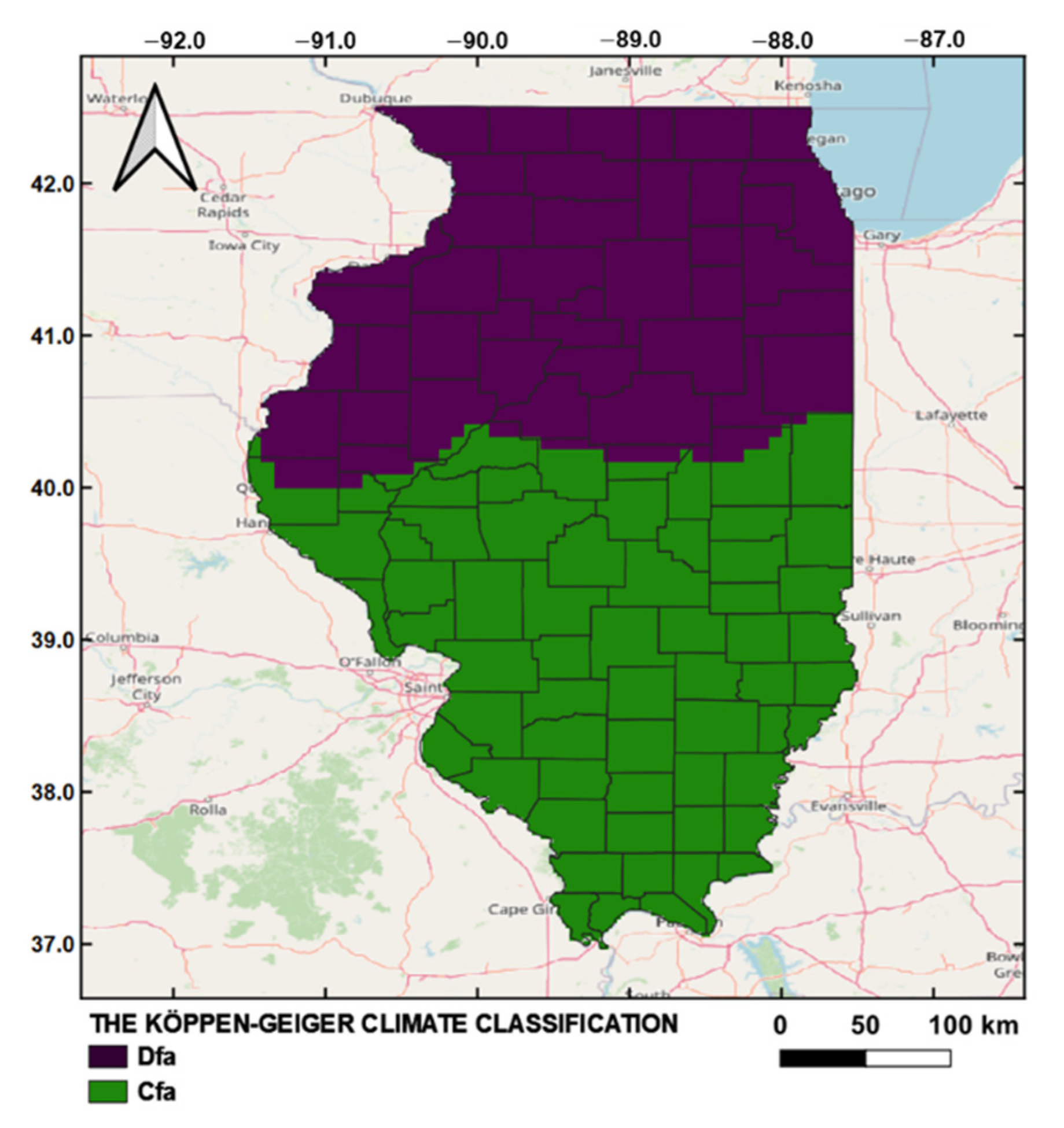





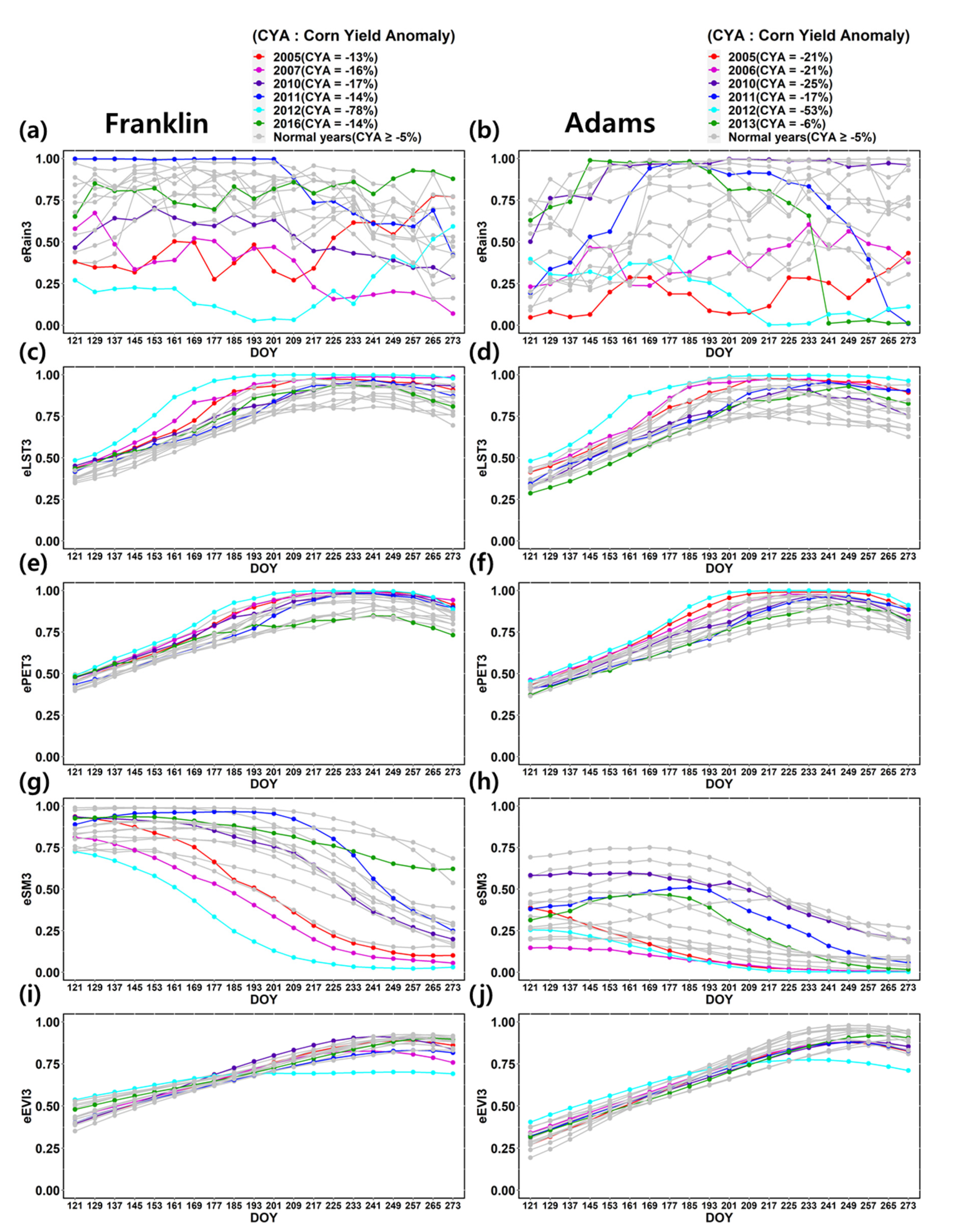
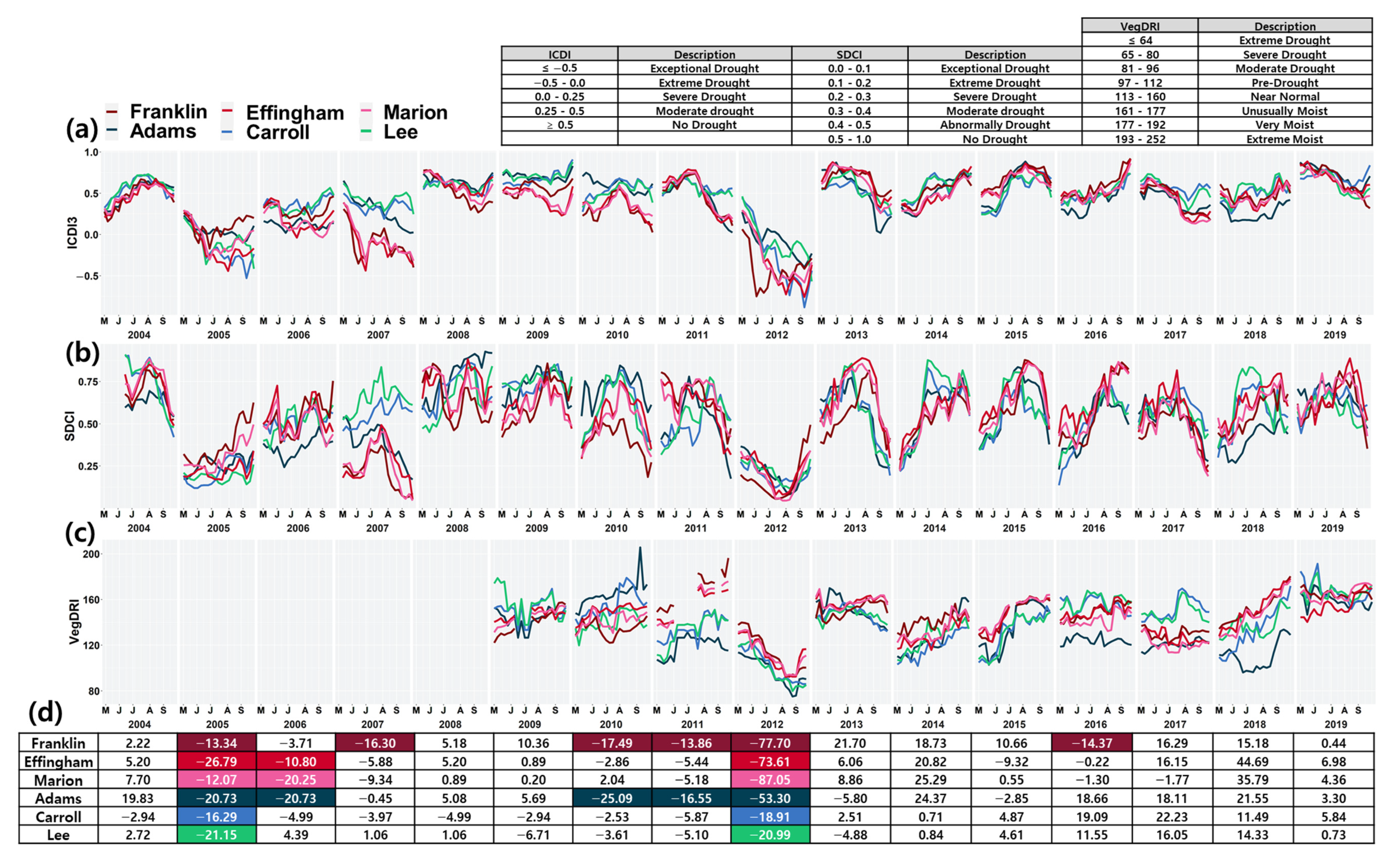
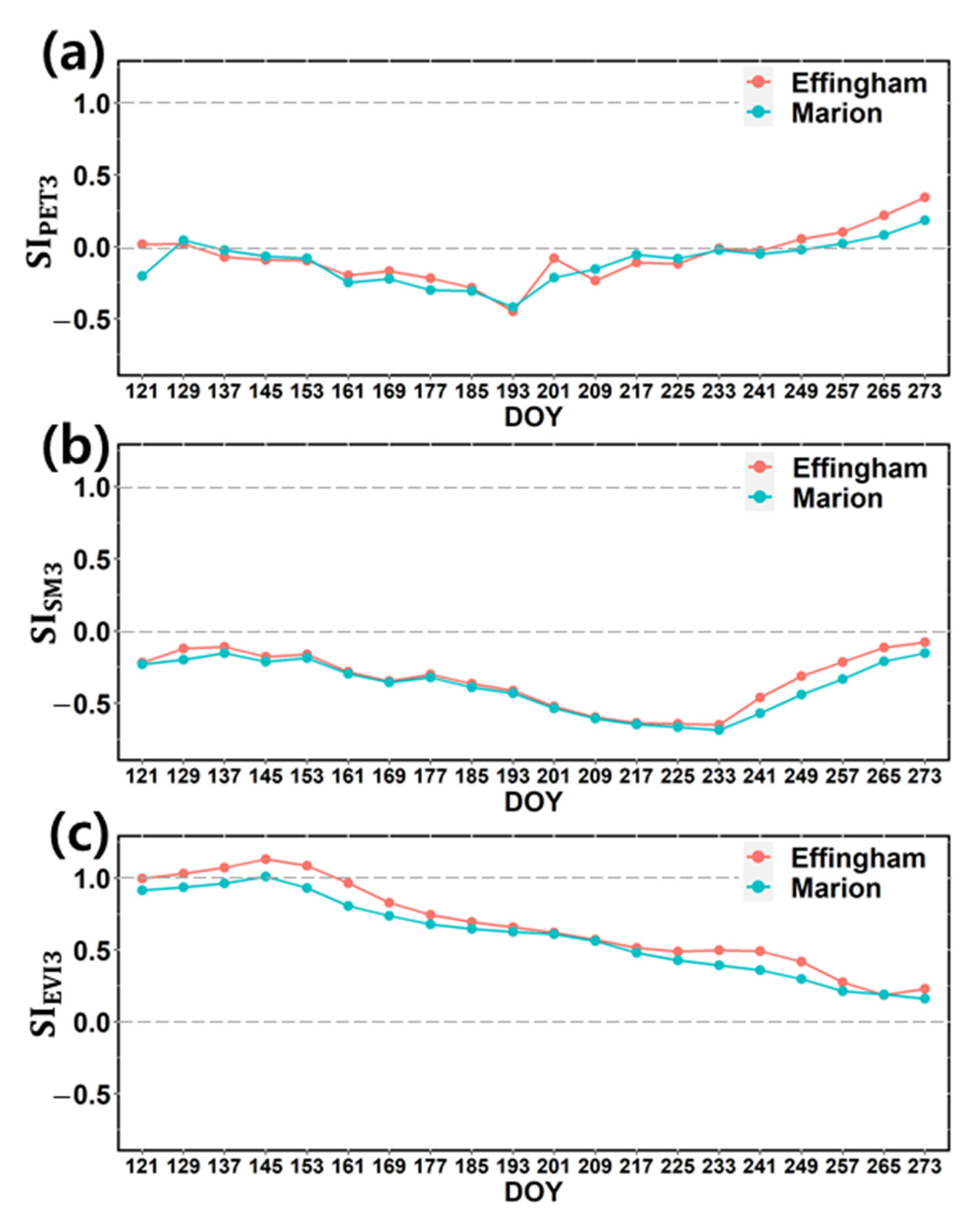

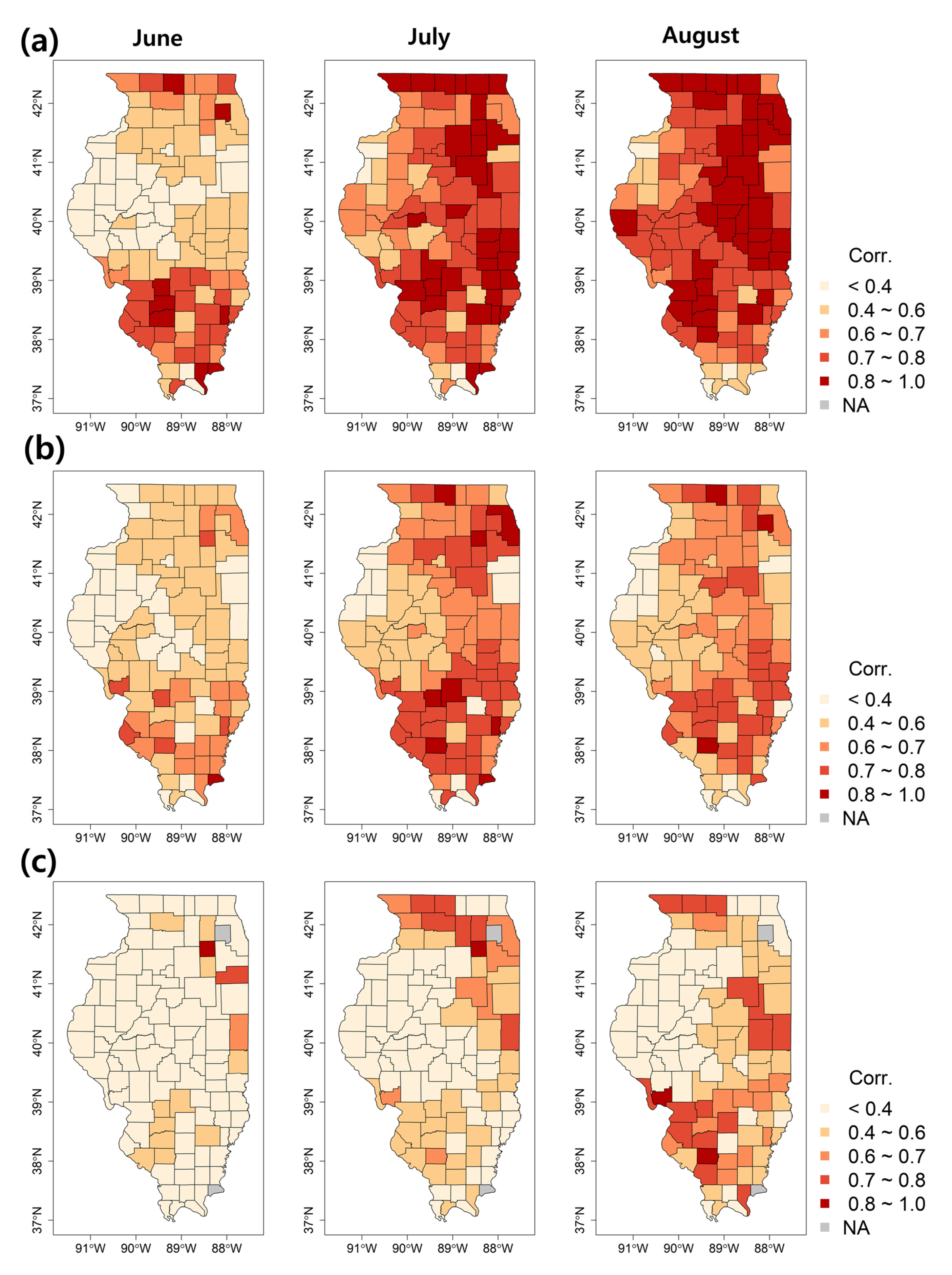

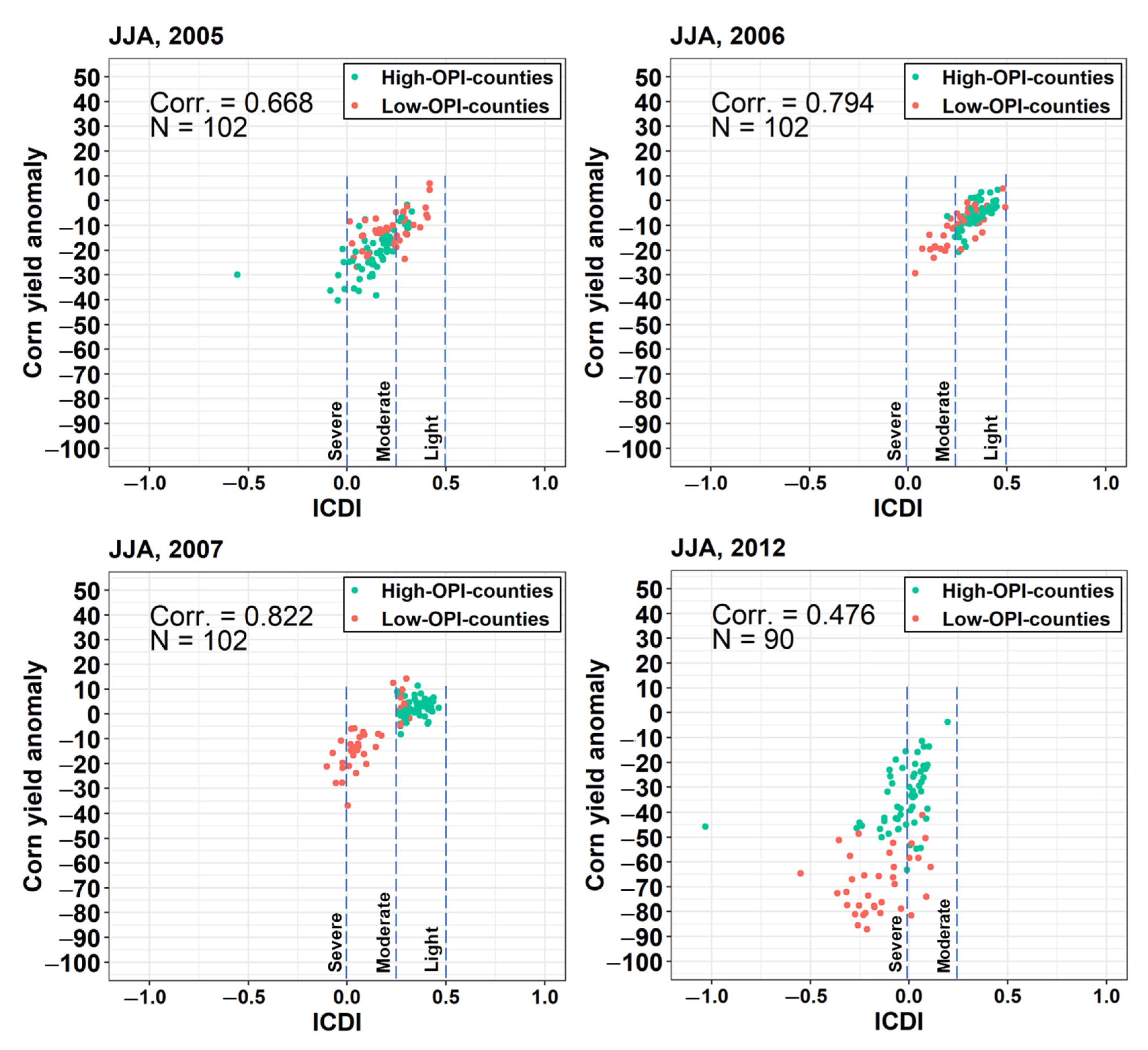
| Drought Index | Rainfall | Temperature | Evapotranspiration | Soil Moisture | Vegetation |
|---|---|---|---|---|---|
| SPI 1 | O | ||||
| SPEI 2 | O | O | |||
| PDSI 3 | O | O | O | O | |
| SWDI 4 | O | ||||
| NDVI 5 | O | ||||
| VHI 6 | O | O | |||
| SDCI 7 | O | O | O | ||
| VegDRI 8 | O | O | O | O |
| Data 1 | Temporal Resolution | Spatial Resolution | Source |
|---|---|---|---|
| Rainfall | Daily | 0.25° | TRMM |
| Land surface temperature (LST) | 8 days | 1 km | Terra MODIS |
| Potential evapotranspiration (PET) | 8 days | 500 m | Terra MODIS |
| Soil moisture (SM) | Daily | 0.25° | GLDAS |
| Enhanced vegetation index (EVI) | Monthly | 0.05° | Terra/Aqua MODIS |
| Land cover type | Yearly | 500 m | Terra/Aqua MODIS |
| Corn yield | Yearly | By county | USDA |
| Variable | Formula |
|---|---|
| Group | County | OPI | Number of the Years Damaged | Average Corn Yield Anomaly during the Years Damaged (%) |
|---|---|---|---|---|
| Severely damaged | Franklin | Low | 6 | 25.510 |
| Effingham | Low | 3 | 37.066 | |
| Marion | Low | 3 | 39.786 | |
| Adams | High | 5 | 27.281 | |
| Moderately damaged | Lee | High | 2 | 21.069 |
| Carroll | High | 2 | 17.600 |
| ICDI | Drought Intensity | Description |
|---|---|---|
| Over 0.5 | No drought | A state which is not a drought. |
| 0.25 to 0.5 | Light drought | A drought, which is endurable for the crops. The air and land surface are slightly dry. |
| 0.0 to 0.25 | Moderate drought | The air and land surface are fairly dry, and there is a possibility of certain damage to the crops. |
| 0.5 to 0.0 | Severe drought | The air and land surface are very dry, and there is a possibility of severe damage to the crops. |
| Under 0.5 | Extreme Drought | The air and land surface are extremely dry, and there is a possibility of very severe damage to the crops. |
| County | Drought Index | June | July | August | Yield Anomaly (%) |
|---|---|---|---|---|---|
| Franklin | ICDI3 | Severe | Moderate | Moderate | 13.34 |
| SDCI | Severe | Moderate | Abnormally | ||
| Effingham | ICDI3 | Severe | Severe | Severe | 26.79 |
| SDCI | Severe | Extreme | Severe | ||
| Marion | ICDI3 | Severe | Severe | Severe | 12.07 |
| SDCI | Severe | Severe | Moderate | ||
| Adams | ICDI3 | Moderate | Moderate | Severe | 20.73 |
| SDCI | Severe | Severe | Severe | ||
| Carroll | ICDI3 | Severe | Severe | Severe | 16.29 |
| SDCI | Severe | Extreme | Extreme | ||
| Lee | ICDI3 | Severe | Severe | Severe | 21.15 |
| SDCI | Severe | Extreme | Extreme |
| County | Drought Index | June | July | August | Yield Anomaly (%) |
|---|---|---|---|---|---|
| Franklin | ICDI3 | Extreme | Severe | Severe | 77.7 |
| SDCI | Extreme | Exceptional | Extreme | ||
| VegDRI | Near Normal | Pre-drought | Moderate | ||
| Effingham | ICDI3 | Severe | Extreme | Extreme | 73.61 |
| SDCI | Severe | Extreme | Extreme | ||
| VegDRI | Near Normal | Pre-drought | Moderate | ||
| Marion | ICDI3 | Severe | Extreme | Extreme | 87.05 |
| SDCI | Severe | Exceptional | Exceptional | ||
| VegDRI | Near Normal | Pre-drought | Moderate | ||
| Adams | ICDI3 | Severe | Moderate | Severe | 53.30 |
| SDCI | Severe | Extreme | Exceptional | ||
| VegDRI | Pre-drought | Moderate | Moderate | ||
| Carroll | ICDI3 | Severe | Severe | Extreme | 18.91 |
| SDCI | Severe | Extreme | Extreme | ||
| VegDRI | Near Normal | Pre-drought | Moderate | ||
| Lee | ICDI3 | Severe | Severe | Severe | 20.99 |
| SDCI | Severe | Extreme | Extreme | ||
| VegDRI | Pre-drought | Moderate | Moderate |
Publisher’s Note: MDPI stays neutral with regard to jurisdictional claims in published maps and institutional affiliations. |
© 2021 by the authors. Licensee MDPI, Basel, Switzerland. This article is an open access article distributed under the terms and conditions of the Creative Commons Attribution (CC BY) license (https://creativecommons.org/licenses/by/4.0/).
Share and Cite
Lee, S.-J.; Kim, N.; Lee, Y. Development of Integrated Crop Drought Index by Combining Rainfall, Land Surface Temperature, Evapotranspiration, Soil Moisture, and Vegetation Index for Agricultural Drought Monitoring. Remote Sens. 2021, 13, 1778. https://doi.org/10.3390/rs13091778
Lee S-J, Kim N, Lee Y. Development of Integrated Crop Drought Index by Combining Rainfall, Land Surface Temperature, Evapotranspiration, Soil Moisture, and Vegetation Index for Agricultural Drought Monitoring. Remote Sensing. 2021; 13(9):1778. https://doi.org/10.3390/rs13091778
Chicago/Turabian StyleLee, Soo-Jin, Nari Kim, and Yangwon Lee. 2021. "Development of Integrated Crop Drought Index by Combining Rainfall, Land Surface Temperature, Evapotranspiration, Soil Moisture, and Vegetation Index for Agricultural Drought Monitoring" Remote Sensing 13, no. 9: 1778. https://doi.org/10.3390/rs13091778
APA StyleLee, S.-J., Kim, N., & Lee, Y. (2021). Development of Integrated Crop Drought Index by Combining Rainfall, Land Surface Temperature, Evapotranspiration, Soil Moisture, and Vegetation Index for Agricultural Drought Monitoring. Remote Sensing, 13(9), 1778. https://doi.org/10.3390/rs13091778







